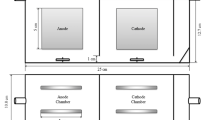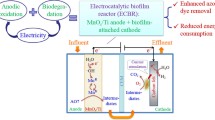Abstract
In this study, a new water treatment system that couples (photo-) electrochemical catalysis (PEC or EC) in a microbial fuel cell (MFC) was configured using a stainless-steel (SS) cathode coated with Fe0/TiO2. We examined the destruction of methylene blue (MB) and tetracycline. Fe0/TiO2 was prepared using a chemical reduction-deposition method and coated onto an SS wire mesh (500 mesh) using a sol technique. The anode generates electricity using microbes (bio-anode). Connected via wire and ohmic resistance, the system requires a short reaction time and operates at a low cost by effectively removing 94% MB (initial concentration 20 mg∙L–1) and 83% TOC/TOC0 under visible light illumination (50 W; 1.99 mW∙cm–2 for 120 min, MFC-PEC). The removal was similar even without light irradiation (MFC-EC). The E Eo of the MFC-PEC system was approximately 0.675 kWh∙m–3∙order–1, whereas that of the MFC-EC system was zero. The system was able to remove 70% COD in tetracycline solution (initial tetracycline concentration 100 mg∙L–1) after 120 min of visible light illumination; without light, the removal was 15% lower. The destruction of MB and tetracycline in both traditional photocatalysis and photoelectrocatalysis systems was notably low. The electron spinresonance spectroscopy (ESR) study demonstrated that ∙OH was formed under visible light, and ∙O –2 was formed without light. The bio-electricity-activated O2 and ROS (reactive oxidizing species) generation by Fe0/TiO2 effectively degraded the pollutants. This cathodic degradation improved the electricity generation by accepting and consuming more electrons from the bio-anode.

Similar content being viewed by others
References
Liu Y B, Li J H, Zhou B X, Li X J, Chen H C, Chen Q P, Wang Z S, Li L, Wang J L, Cai W M. Efficient electricity production and simultaneously wastewater treatment via a high-performance photocatalytic fuel cell. Water Research, 2011, 45(13): 3991–3998
Lin L, Wang H Y, Luo H M, Xu P. Enhanced photocatalysis using side-glowing optical fibers coated with Fe-doped TiO2 nanocomposite thin films. Journal of Photochemistry and Photobiology A Chemistry, 2015, 307–308: 88–98
Chen Q P, Bai J, Li J H, Huang K, Li X J, Zhou B X, Cai W M. Aerated visible-light responsive photocatalytic fuel cell for wastewater treatment with producing sustainable electricity in neutral solution. Chemical Engineering Journal, 2014, 252: 89–94
Lai B, Wang P, Li H R, Du Z W, Wang L J, Bi S C. Calcined polyaniline-iron composite as a high efficient cathodic catalyst in microbial fuel cells. Bioresource Technology, 2013, 131: 321–324
Li J Y, Li J H, Chen Q P, Bai J, Zhou B X. Converting hazardous organics into clean energy using a solar responsive dual photoelectrode photocatalytic fuel cell. Journal of Hazardous Materials, 2013, 262: 304–310
Jadhav D A, Ghadge A N, Ghangrekar M M. Enhancing the power generation in microbial fuel cells with effective utilization of goethite recovered from mining mud as anodic catalyst. Bioresource Technology, 2015, 191: 110–116
Lee K Y, RyuW S, Cho S I, Lim K H. Comparative study on power generation of dual-cathode microbial fuel cell according to polarization methods. Water Research, 2015, 84: 43–48
Wang A J, Cheng H Y, Ren N Q, Cui D, Lin N,WuW M. Sediment microbial fuel cell with floating biocathode for organic removal and energy recovery. Frontiers of Environmental Science and Engineering, 2012, 6(4): 569–574
Liang P, Wei J C, Li M, Huang X. Scaling up a novel denitrifying microbial fuel cell with an oxic-anoxic two stage biocathode. Frontiers of Environmental Science and Engineering, 2013, 7(6): 913–919
Liu W F, Cheng S A, Sun D, Huang B, Chen J, Cen K F. Inhibition of microbial growth on air cathodes of single chamber microbial fuel cells by incorporating enrofloxacin into the catalyst layer. Biosensors & Bioelectronics, 2015, 72: 44–50
Liao Z H, Sun J Z, Sun D Z, Si R W, Yong Y C. Enhancement of power production with tartaric acid doped polyaniline nanowire network modified anode in microbial fuel cells. Bioresource Technology, 2015, 192: 831–834
Xiao Y, Zheng Y, Wu S, Yang Z H, Zhao F. Nitrogen recovery from wastewater using microbial fuel cells. Frontiers of Environmental Science and Engineering, 2016, 10(1): 185–191
Wang Z J, Zhang B G, Alistair G L B, Feng C Q, Ni J R. Utilization of single-chamber microbial fuel cells as renewable power sources for electrochemical degradation of nitrogen-containing organic compounds. Chemical Engineering Journal, 2015, 280: 99–105
Tang WW, Chen X Y, Xia J, Gong JM, Zeng X P. Preparation of an Fe-doped visible-light-response TiO2 film electrodeand its photoelectrocatalytic activity. Materials Science and Engineering B, 2014, 187: 39–45
Ding X, Ai Z H, Zhang L Z. A dual-cell wastewater treatment system with combining anodic visible light driven photoelectrocatalytic oxidation and cathodic electro-Fenton oxidation. Separation and Purification Technology, 2014, 125: 103–110
Li J, Lv S, Liu Y, Bai J, Zhou B, Hu X. Photoeletrocatalytic activity of an n-ZnO/p-Cu2O/n-TNA ternary heterojunction electrode for tetracycline degradation. Journal of Hazardous Materials, 2013, 262: 482–488
Liu Y B, Li H, Zhou B X, Lv S B, Li X J, Chen H C, Chen Q P, Cai W M. Photoelectrocatalytic degradation of refractory organic compounds enhanced by a photocatalytic fuel cell. Applied Catalysis B: Environmental, 2012, 111–112: 485–491
Xu S C, Pan S S, Xu Y, Luo Y Y, Zhang Y X, Li G H. Efficient removal of Cr(VI) from wastewater under sunlight by Fe(II)-doped TiO2 spherical shell. Journal of Hazardous Materials, 2015, 283: 7–13
Chen C, LongMC, Zeng H, CaiWM, Zhou B X, Zhang J Y, Wu Y, Ding D W, Wu D Y. Preparation, characterization and visible-light activity of carbon modified TiO2 with two kinds of carbonaceous species. Journal of Molecular Catalysis A Chemical, 2009, 314(1–2): 35–41
Yao Y, Li K, Chen S, Ji J P, Wang Y L, Wang H W. Decolorization of Rhodamine B in a thin-film photoelectrocatalytic (PEC) reactor with slant-placed TiO2 nanotubes electrode. Chemical Engineering Journal, 2012, 187: 29–35
Hsieh W P, Pan J R, Huang C, Su Y C, Juang Y J. Enhance the photocatalytic activity for the degradation of organic contaminants in water by incorporating TiO2 with zero-valent iron. Science of the Total Environment, 2010, 408(3): 672–679
Rodriguez S, Vasquez L, Costa D, Romero A, Santos A. Oxidation of Orange G by persulfate activated by Fe(II), Fe(III) and zero valent iron (ZVI). Chemosphere, 2014, 101: 86–92
Wang Z Q, Wen B, Hao Q Q, Liu LM, Zhou C, Mao X, Lang X, Yin W J, Dai D, Selloni A, Yang X. Localized excitation of Ti3+ ions in the photoabsorption and photocatalytic activity of reduced rutile TiO2. Journal of the American Chemical Society, 2015, 137(28): 9146–9152
Xu Y L, Jia J P, Zhong D J, Wang Y L. Degradation of dye wastewater in a thin-film photoelectrocatalytic (PEC) reactor with slant-placed TiO2/Ti anode. Chemical Engineering Journal, 2009, 150(2–3): 302–307
Yang J, Cao M, Guo R, Jia J P. Permeable reactive barrier of surface hydrophobic granular activated carbon coupled with elemental iron for the removal of 2,4-dichlorophenol in water. Journal of Hazardous Materials, 2010, 184(1–3): 782–787
Kim J H, Park I S, Park J Y. Electricity generation and recovery of iron hydroxides using a single chamber fuel cell with iron anode and air-cathode for electrocoagulation. Applied Energy, 2015, 160: 18–27
Liu L F, Chen F, Yang F L, Che Y S, Crittenden J. Photocatalytic degradation of 2,4-dichlorophenol using nanoscale Fe/TiO2. Chemical Engineering Journal, 2012, 181–182: 189–195
Daneshvar N, Aber S, Seyed DorrajiM S, Khataee A R, Rasoulifard M H. Photocatalytic degradation of the insecticide diazinon in the presence of prepared nanocrystalline ZnO powders under irradiation of UV-C light. Separation and Purification Technology, 2007, 58(1): 91–98
Muruganandham M, Selvam K, Swaminathan M. A comparative study of quantum yield and electrical energy per order (EEo) for advanced oxidative decolourisation of reactive azo dyes by UV light. Journal of Hazardous Materials, 2007, 144(1–2): 316–322
Daneshvar N, Aleboyeh A, Khataee A R. The evaluation of electrical energy per order (EEo) for photooxidative decolorization of four textile dye solutions by the kinetic model. Chemosphere, 2005, 59(6): 761–767
Behnajady M A, Vahid B, Modirshahla N, Shokri M. Evaluation of electrical energy per order (EEo) with kinetic modeling on the removal of Malachite Green by US/UV/H2O2 process. Desalination, 2009, 249(1): 99–103
He C, Yu Y, Hu X F, Larbot A. Influence of silver doping on the photocatalytic activity of titania films. Applied Surface Science, 2002, 200(1–4): 239–247
Atsushi K.A combination of Electron Spin Resonance spectroscopy/ atom transfer radical polymerization (ESR/ATRP) techniques for fundamental investigation of radical polymerizations of (meth) acrylates. Polymer, 2015, 72: 253–263
Fujishima A, Zhang X, Tryk D A. TiO2 photocatalysis and related surface phenomena. Surface Science Reports, 2008, 63(12): 515–582
Huang C, Hsieh W P, Pan J R, Chang S M. Characteristic of an innovative TiO2/Fe0 composite for treatment of azo dye. Separation and Purification Technology, 2007, 58(1): 152–158
Jayanthi Kalaivani G, Suja S K. TiO2 (rutile) embedded inulin—A versatile bio-nanocomposite for photocatalytic degradation of methylene blue. Carbohydrate Polymers, 2016, 143: 51–60
Shestakova M, Graves J, Sitarz M, Sillanpää M. Optimization of Ti/Ta2O5–SnO2 electrodes and reaction parameters for electrocatalytic oxidation of methylene blue. Journal of Applied Electrochemistry, 2016, 46(3): 349–358
Author information
Authors and Affiliations
Corresponding author
Rights and permissions
About this article
Cite this article
Jiang, C., Liu, L. & Crittenden, J.C. An electrochemical process that uses an Fe0/TiO2 cathode to degrade typical dyes and antibiotics and a bio-anode that produces electricity. Front. Environ. Sci. Eng. 10, 15 (2016). https://doi.org/10.1007/s11783-016-0860-z
Received:
Revised:
Accepted:
Published:
DOI: https://doi.org/10.1007/s11783-016-0860-z




